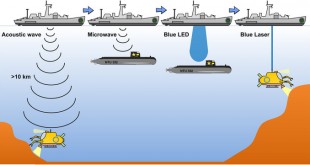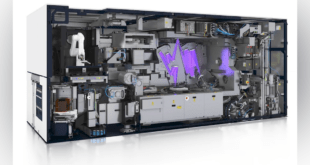China is developing a new type of spy satellite using ghost imaging technology which could spot stealth aircraft and see through smokescreens and camouflage.
Ron Meyers, quantum physicist at the Army Research Laboratory. Meyers explained ghost imaging, a technique that allows a high resolution camera to produce an image of an object which the camera itself cannot see. It uses two sensors, one that looks at a light source and another that looks at the object. A computer program then compares and combines the patterns received from the object and the light. This creates a “ghost image,” a black and white or color picture of the object being photographed. The earliest “ghost images” were silhouettes but current ones depict the objects more realistically. “I think, or I would hope, in a few years that we have a soldier using a quantum ghost imaging imager to look through battlefield smoke and identifying friend or foe,” Meyers said.
Quantum ghost imaging can achieve unprecedented sensitivity by detecting not just the extremely small amount of light straying off a dim target, but also its interactions with other light in the surrounding environment to obtain more information than traditional methods.
Gong Wenlin, research director at the Key Laboratory for Quantum Optics, Chinese Academy of Sciences in Shanghai – whose team is building the prototype ghost imaging device for satellite missions – said their technology was designed to catch “invisibles” like the B-2s.
Tang Lingli, a researcher with the Academy of Opto-Electronics, Chinese Academy of Sciences in Beijing, said numerous new devices had been built, tested in the field and were ready for deployment on ground-based radar stations, planes and airships.
While ghost imaging has already been tested on ground-based systems, Gong’s lab is in a race with overseas competitors, including the US Army Research Laboratory, to launch the world’s first ghost imaging satellite.
The chinese team showed the engineering feasibility of the technology with a ground experiment in 2011. Three years later the US army lab announced similar results.
Ghost imaging spy satellite a game changer for Chinese military
The ghost imaging satellite would have two cameras, one aiming at the targeted area of interest with a bucket-like, single pixel sensor while the other camera measured variations in a wider field of light across the environment.
The target could be illuminated by almost any light source such as the sun, moon or even a fluorescent light bulb. Alternatively, a pair of physically “entangled” or “correlated” laser beams could be generated from the satellite to light up the object and its surroundings.
By analyzing and merging the signals received by the two cameras with a set of sophisticated algorithms in quantum physics, scientists could conjure up the imaging of an object with extremely high definition previously thought impossible using conventional methods.
Gong said darkness, cloud, haze and other negative elements impairing visibility would no longer matter. “A ghost imaging satellite will reveal more details than the most advanced radar satellite,” the research director said.
The ghost camera could also identify the physical nature or even chemical composition of a target, according to Gong. This meant the military would be able to distinguish decoys such as fake fighter jets on display in an airfield or missile launchers hidden under a camouflage canopy.
He said his lab, led by prominent quantum optics physicist Han Shensheng, would complete a prototype by 2020 with an aim to test the technology in space before 2025. By 2030 he said there would be some large-scale applications.
ARL’s ‘ghost imaging’ cuts through battlefield turbulence
The ARL team has been studying ghost imaging since 2003 — and invented remote ghost imaging in 2007 — and has set a goal of using it to improve Intelligence, Surveillance and Reconnaissance from the ground, satellites and unmanned aerial vehicles. The new system represents that latest in what have been regular improvements in the technology.
And for troops, the bottom line is that quantum imaging can give them a clearer view of what’s ahead.
Quantum imaging, also known as ghost imaging, is based on the quantum properties of photons, electrons and atoms. The method filters out atmospheric turbulence and other irregularities, creating an image that you couldn’t see through the lens of a camera, and works at any wavelength, ARL said.
Meyers, who has 19 patents in quantum physics and related technologies, described the Quantum Imaging Camera as “a new and better way to get a picture.” It not only eliminates the distortions that visible-light imaging can fall victim to, but it also improves on infrared imaging, which, while effective in low light, does have its limitations.
Researchers tested the system at a distance of 2.33 kilometers (about 1.45 miles) and came up with a surprisingly clear image despite a high level of turbulence and low-light conditions, ARL said.
Ghost imaging
Ghost imaging (also called “coincidence imaging”, “two-photon imaging” or “correlated-photon imaging”) is a technique that produces an image of an object by combining information from two light detectors: a conventional, multi-pixel detector that doesn’t view the object, and a single-pixel (bucket) detector that does view the object.
Two techniques have been demonstrated. A quantum method uses a source of pairs of entangled photons, each pair shared between the two detectors, while a classical method uses a pair of correlated coherent beams without exploiting entanglement. Both approaches may be understood within the framework of a single theory.
A simple example clarifies the basic principle of ghost imaging. Imagine two transparent boxes: one that is empty and one that has an object within it. The back wall of the empty box contains a grid of many pixels (i.e. a camera), while the back wall of the box with the object is a large single-pixel (a bucket detector). Next, shine laser light into a beamsplitter and reflect the two resulting beams such that each passes through the same part of its respective box at the same time. For example, while the first beam passes through the empty box to hit the pixel in the top-left corner at the back of the box, the second beam passes through filled box to hit the top-left corner of the bucket detector.
Now imagine moving the laser beam around in order to hit each of the pixels at the back of the empty box, meanwhile moving the corresponding beam around the box with the object. While the first light beam will always hit a pixel at the back of the empty box, the second light beam will sometimes be blocked by the object and will not reach the bucket detector. A processor receiving a signal from both light detectors only records a pixel of an image when light hits both detectors at the same time. In this way, a silhouette image can be constructed, even though the light going towards the multi-pixel camera did not touch the object.
Other method of ghost imaging is based on the quantum nature of light. Specifically, quantum correlations between photon pairs were used to build up an image. One of the photons of the pair strikes the object and then the bucket detector while the other follows a different path to a (multi-pixel) camera. The camera is constructed to only record pixels from photons that hit both the bucket detector and the camera’s image plane.
The spontaneous parametric down-conversion (SPDC) process provides a convenient source of entangled-photon pairs with strong spatial correlations. Such heralded single photons can be used to achieve a high signal-to-noise ratio, virtually eliminating background counts from the recorded images. By applying principles of image compression and associated image reconstruction, high-quality images of objects can be formed from raw data with an average of fewer than one detected photon per image pixel
References and Resources also include:
https://en.wikipedia.org/wiki/Ghost_imaging
https://defensesystems.com/articles/2014/01/06/arl-quantum-ghost-imaging.aspx
 International Defense Security & Technology Your trusted Source for News, Research and Analysis
International Defense Security & Technology Your trusted Source for News, Research and Analysis


